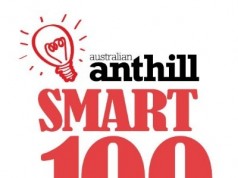Like this innovation? Show your support by tweeting it, ‘liking’ it on Facebook, or leaving a comment below.
1. THE BEGINNING
This innovation came to life when…
Alec Lynch, the founder and CEO of DesignCrowd, identified that the traditional design marketplace is extremely flawed. It’s slow, expensive and risky.
The uninspired London Olympics’ logo for 2007 confirmed this for Alec. The logo cost £400,000, took a year to make and received a lot of backlash from media and the public.
DesignCrowd launched to fix these problems in the design marketplace. Unlike other basic/pure crowdsourcing players in the market, DesignCrowd uses their refined, innovative crowdsourcing 2.0 model to deliver a fairer and more sustainable crowdsourcing model.
2. WHAT & HOW
The purpose of this innovation is to…
DesignCrowd was launched to create a faster, cheaper, fairer, risk-free design marketplace.
It does this by…
It does this through their Crowdsourcing 2.0 model, moving from the basic crowdsourcing concept (which uses open competition, relies on ‘free’ work) to a refined crowdsourcing model which controls and measures the process to deliver fairer and more sustainable crowdsourcing. It is moving from a ‘people don’t get paid’ model to a sustainable model where ‘everyone gets paid’.
3. PURPOSE & BENEFITS
This innovation improves on what came before because…
As part of Crowdsourcing 2.0, DesignCrowd introduced Participation Payments, where designers get paid for participating. Already over $2 million in participation payments has been paid, making it fairer for designers.
The benefits to the customer/end-user include…
There is no reason crowdsourcing has to be ‘winner takes all’ or require ‘free participation’. Crowdsourcing 2.0 means more designers get paid, customers feel better using a model that’s fair and the platform attracts better designers, and therefore more business.
4. COMPETITIVE LANDSCAPE
In the past, this problem was solved by…
Other crowdsourcing players were/still are using the basic crowdsourcing concept — an open competition relying on ‘free’ work. This means a lot of designers don’t get paid for the work they do.
Its predecessors/competitors include…
Traditional design agencies and crowdsourcing and outsourcing companies.
5. TARGET MARKET
This innovation is made for…
DesignCrowd is competing in the global graphic design industry which is valued at approximately $44 billion dollars. DesignCrowd is a two-sided marketplace, targeting its service toward designers and traditional agencies and businesses. The company has doubled the business size in six months, launching in Singapore, India, Philippines, USA, Australia, New Zealand, UK, Canada.
6. DISTRIBUTION STRATEGY
It is available for sale through…
It is available through www.designcrowd.com, the second largest online design crowdsourcing marketplace in the world.
Our marketing strategy is to…
DesignCrowd has a fanatically focused customer service team known internally as the justice league.
DesignCrowd use a combination of online marketing techniques and seizes upon media opportunities when they present. They are thought-leaders in their space (speaking/guest editorial/blogging). They apply a data-driven, measurable approach to online marketing and are a social-marketing-focused brand, leveraging the community of designers/customers.
Your Turn — VOTE!
If this SMART 100 innovation wowed you, why not get the word out?
- Tweet it: Top left of each page
- Trigger a Reaction: Facebook ‘Like’, etc.
- Leave a Comment: Anonymous comments excluded.
We’ll use your vote to create the 2013 SMART 100 Readers’ Choice Index. Learn more here!
FINE PRINT
This SMART 100 profile and the information it contains is a duplication of content submitted by the applicant during the entry process. As a function of entry, applicants were required to declare that all details are factually correct, do not infringe on another’s intellectual property and are not unlawful, threatening, defamatory, invasive of privacy, obscene, or otherwise objectionable. Some profiles have been edited for reasons of space and clarity.





![Five essential ingredients for a humming homepage with James Tuckerman [FREE REPORT]](https://anthillonline.com/wp-content/uploads/2015/07/homepage-checklist-1680-01-copy-300x194.png)
![The Facebook Honey Trap with James Tuckerman [CHEAT SHEET]](https://anthillonline.com/wp-content/uploads/2015/11/Screen-Shot-2015-11-26-at-11.34.14-100x75.png)
![How to market your business when you don’t have a business yet [CHEAT SHEET]](https://anthillonline.com/wp-content/uploads/2016/01/oli-gardner-memes-02-100x75.jpg)
![How Master the Art of Sales Even if it Makes You Feel All Weird and Icky Inside with Phil Anderson [CHEAT SHEET]](https://anthillonline.com/wp-content/uploads/2015/08/PHIL-ANDERSON-COVER-100x75.png)
![The Gaddie Pitch in three simple sentences with Antony Gaddie and James Tuckerman [CHEAT SHEET]](https://anthillonline.com/wp-content/uploads/2015/08/GADDIE-PITCH-updated-3D-cover--100x75.png)
![The Ultimate Social Media Almanac with James Tuckerman [Cheat Sheet]](https://anthillonline.com/wp-content/uploads/2015/11/Screen-Shot-2015-11-26-at-11.24.55-100x75.png)
![Sometimes we need to be heard. But, sometimes we also need to hear what the listener has to say [VIDEO]](https://anthillonline.com/wp-content/uploads/2013/09/TheNail-300x350.jpg)

![Why you need a visual story about your business [VIDEO]](https://anthillonline.com/wp-content/uploads/2014/11/storytelling-300x350.jpg)
![Flearning 101: How Comixology became the #1 grossing iPad app [VIDEO]](https://anthillonline.com/wp-content/uploads/2013/11/comixology-300x350.jpg)
![Ever considered crowdfunding? [FREE REPORT]](https://anthillonline.com/wp-content/uploads/2017/03/liz-wald-300x194.png)
![Generating Web Traffic with Mark Middo and James Tuckerman [FREE REPORT]](https://anthillonline.com/wp-content/uploads/2015/08/Capture3-100x75.jpg)
![The Top 5 Most Insanely Dumb Mistakes made by Rookie and Seasoned LinkedIn Users, with David Hobson [FREE REPORT]](https://anthillonline.com/wp-content/uploads/2015/07/Screen-Shot-2015-11-26-at-14.29.18-100x75.png)
![How to confidently raise venture capital… with Jack Delosa [CHEAT SHEET]](https://anthillonline.com/wp-content/uploads/2016/04/jack-de-losa-confidently-raising-venture-NFSU-rebrand-01.pdf-Box-2016-04-19-12-37-42-100x75.png)
![How to price your product or service in 8 steps with Steve Major [FREE INFOGRAPHIC]](https://anthillonline.com/wp-content/uploads/2015/07/Screen-Shot-2015-11-26-at-11.40.10-100x75.png)
![New Zealand’s Xero eyes US IPO, further disruption as subscribers increase [INFOGRAPHIC]](https://anthillonline.com/wp-content/uploads/2014/07/sruuuuujana-212x194.png)
![Ever wonder if your ‘content marketing’ is really just crap? You gotta see this! [INFOGRAPHIC]](https://anthillonline.com/wp-content/uploads/2014/08/content-100x75.jpg)
![7 Business Lessons From Game of Thrones [INFOGRAPHIC]](https://anthillonline.com/wp-content/uploads/2014/10/infographic-games-of-thrones-041-100x75.jpg)
![How to build your own Media Empire… In seven steps with Nathan Chan [INFOGRAPHIC]](https://anthillonline.com/wp-content/uploads/2014/10/Nathan-Chan-Infographic-e1413419529176-100x75.jpg)
![5 Business Lessons From Tinder [INFOGRAPHIC]](https://anthillonline.com/wp-content/uploads/2014/10/Tinder-Elegant-Infographic-100x75.jpg)



